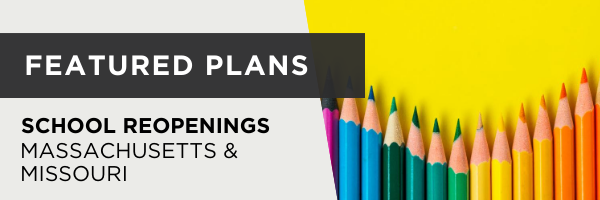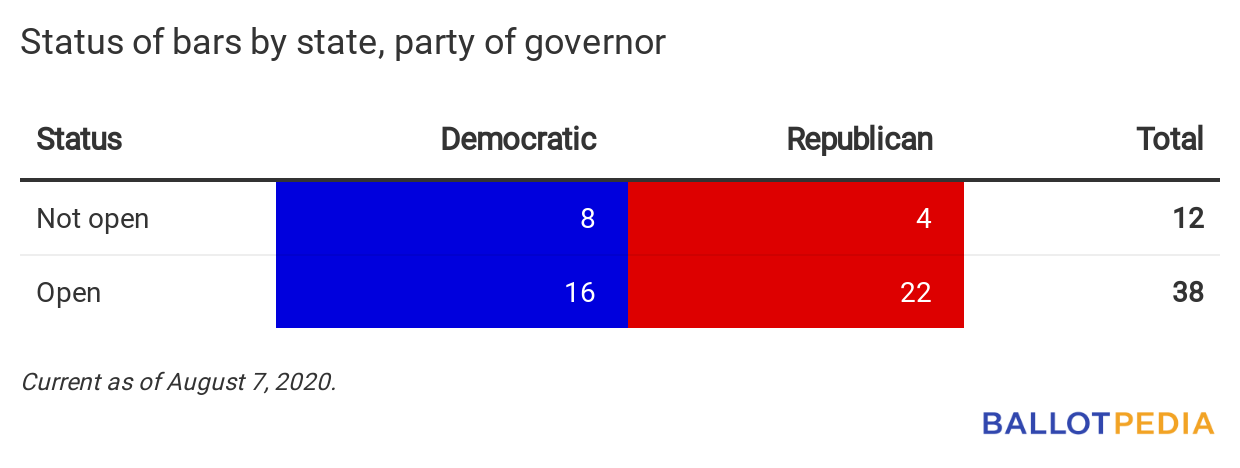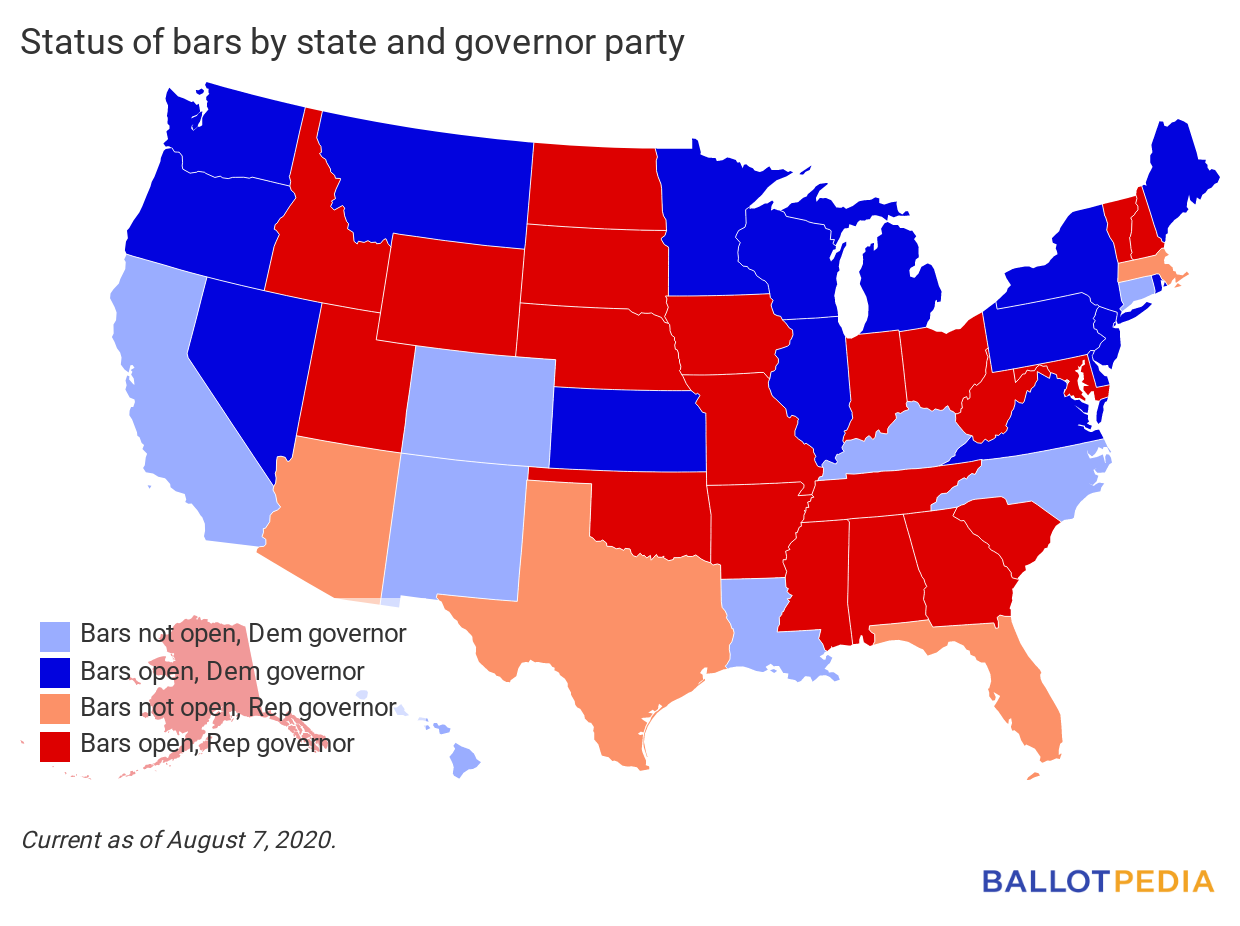Each day, we:
Want to know what happened yesterday? Click here. Since our last editionWhat is open in each state? For a continually updated article on reopening status in all 50 states, click here. For our last edition, click here.
Tracking industries: BarsAll 50 states are reopening in some way. Here, we give the status of one industry or activity across the states. Today’s question: in which states may you go out for a drink? We last looked at bars in the July 31st edition of the newsletter. Since then, no states have opened or restricted service at bars. Alex Harring and Noah Higgins-Dunn of CNBC noted the recent trend has been to adjust service hours rather than closing service. “Positioned as alternatives to stricter mandates, the regulations sprang up after governors in states with surging outbreaks, such as Texas, California, and Florida, were forced to close bars only a few weeks after they were reopened,” they wrote.
|
||||||||||||||||||||||||||||||||||||||||||||||||||||||||||||||||||||||||||||||||||||

This is an in-depth summary of two state plans to reopen public K-12 schools for the 2020-2021 school year. Massachusetts’s Initial Fall School Reopening GuidanceThe Massachusetts Department of Elementary and Secondary Education released preliminary guidance for reopening schools on June 8. On June 24, Gov. Charlie Baker (R) released additional guidance for reopening schools. In a press conference, Baker said, “Continued isolation poses very real risks to our kids’ mental and physical health, and to their educational development. This plan will allow schools to responsibly do what is best for students, which is to bring them back to school to learn and grow.” Following negotiations with the state’s teachers unions, Education Commissioner Jeff Riley announced on July 27 that the 2020-2021 school year would be reduced from 180 to 170 days to give schools more time to prepare, with classes starting no later than Sept. 16. According to EdWeek, public schools in Massachusetts traditionally start the academic year in late August to early September. On March 15, Gov. Baker closed schools from March 17 to April 6. On March 25, Baker extended the closure through May 1. The governor closed schools for the rest of the academic year on April 21. ContextMassachusetts has a divided government. The governor is a Republican, and Democrats have majorities in both chambers of the state legislature. The state has had a divided government since 2015. The following tables show public education statistics in Massachusetts, including a rank comparing it to the other 49 states. Rank one is the highest number of each figure, rank 50 is the lowest. All data comes from the Common Core of Data provided by the National Center for Education Statistics.
DetailsDistrict reopening plans Districts are responsible for developing their own specific reopening plans for three possible learning models: all in-person learning, all remote, and a hybrid of the two. Preliminary plans were due at the end of July, with comprehensive plans due Aug. 10. These plans have to be submitted to the state as well as released publicly. In-person, hybrid, and online learning The state working group has prioritized returning “as many students as possible to in-person school settings,” but asked districts to have three separate plans “to ensure continuity of learning throughout the school year, even if circumstances change.” For the in-person model, districts are told to plan for school five days a week. Alternative school spaces, such as libraries and cafeterias, as well as external spaces such as community centers, should be used as classrooms to reduce class size and increase distancing. Class sizes should also be reduced by using specialist teachers as core teachers when possible. Students are to be placed in classes/cohorts and kept together when possible. For the hybrid model, two distinct groups of students should be isolated and attend school in-person on different weeks, different days of the week, or half days each day. High-needs students and students without Internet and/or computer access should be prioritized for in-person learning. Mask requirements Students in second grade and above are required to wear facial coverings, while students in kindergarten and first grade are encouraged to wear them, with family-provided face coverings. All adults are required to wear face coverings. In-person health recommendations and requirements Schools are encouraged to keep students six feet apart when possible, with three feet required. Similarly, desks are recommended to be six feet apart but no less than three feet apart, and all face the same direction. Students should be grouped into cohorts/classes that remain together throughout the day, with contact between cohorts/classes minimized. There is no maximum group size, as long as minimum physical distancing is possible. While schools should provide information to families on how to check for symptoms, screening procedures, including temperature checks, are not required to enter a school. Hand washing or sanitizing is required upon arriving at school, before eating, before putting on and removing masks, and before being dismissed. Schools are required to have an isolation space separate from the nurse’s office where students displaying symptoms can be moved until a family member picks them up. Transportation and busing requirements and restrictions The Department of Elementary and Secondary Education released separate guidance on July 22 covering transportation. Under these guidelines, everyone riding on the bus must wear a mask. Unless there is inclement weather, windows are to be kept open at all times. Students will have assigned seats, with one to each seat, and capacity reduced by bus size. Districts are advised to consider adding routes, staggering start and end times, and encourage alternative transportation. Responses
Missouri’s Pandemic Recovery Considerations and Missouri School Reopening Guidance Frequently Asked Health-Related COVID-19 QuestionsOn July 9, the Missouri Department of Elementary and Secondary Education (DESE) and the Department of Health and Senior Services (DHSS) issued Missouri School Reopening Guidance Frequently Asked Health-Related COVID-19 Questions. The FAQ clarifies and expands the initial guidance released in May. The FAQ was last updated on Aug. 3. The initial guidance was released with the assistance of the Missouri School Boards Association and titled Pandemic Recovery Considerations: Re-Entry and Reopening of Schools. It says “The intent of this document is to create a template to guide local discussion regarding reopening schools and is not a ‘one size, fits all’ document.” Both the FAQ and Pandemic Recovery Considerations emphasize that Missouri does not have a centralized plan for reopening schools, leaving decisions about how to reopen to local counties and school boards. On July 10, Gov. Mike Parson (R) said, “I talked to some of the school administrators, the teachers, the students. I don’t think there’s any question in the state of Missouri – we’ve got to get the schools opened back up and we’ve got to get the kids back to school. There’s a lot of things that occur by not having them in school that can be far worse than going in there and fighting a virus.” Missouri school districts are required to open by Aug. 24 but can apply for a waiver from the DESE to push that date back. According to EdWeek, public schools in Missouri traditionally start the academic year in late August. On March 19, Gov. Parson announced all school districts had chosen to temporarily close, but that he had not issued a statewide closure. Later, the DESE announced schools would not reopen until at least April 6. On April 3, Parson issued a stay-at-home order that extended the closure through April 24. Parson closed schools for the remainder of the academic year on April 9. ContextMissouri has a Republican trifecta. The governor is a Republican, and Republicans hold majorities in both chambers of the state legislature. It has been a Republican trifecta since 2017. The following tables show public education statistics in Missouri, including a rank comparing it to the other 49 states. Rank one is the highest number of each figure, rank 50 is the lowest. All data comes from the Common Core of Data provided by the National Center for Education Statistics.
DetailsDistrict reopening plans Reopening plans have been left up to individual counties and school boards. Local schools and local jurisdictions are allowed to implement measures that are more or less stringent than the DESE recommends. In-person, hybrid, and online learning The DESE gives schools districts latitude to decide which model of learning to adopt. For example, St. Louis area school districts have varied widely, with some deciding on fully in-person, some fully online, and some hybrid. Additionally, some districts have offered parents the choice between two or more of these models. Mask requirements The DESE has not issued a mask requirement for schools. The FAQ recommends face coverings for all age groups whenever students are not in a cohort or are unable to physically distance. Continuous use of masks is not suggested for young children but is for older children. Masks are also recommended while riding the bus. The FAQ recommends adult staff wear masks at all times when social distancing isn’t possible. In-person health recommendations and requirements While the state has issued no mask requirements for schools, the DESE has offered several recommendations: Schools should encourage parents to screen children at home, and those with symptoms should not attend school and consult healthcare providers about returning to school. Those diagnosed with COVID-19 should be allowed to return to school after 10 days, including three days without fever. Schools should monitor children for visual signs of infection, and limit outside visitors. Physical distancing of three to six feet is suggested, with students assigned to cohorts, staying with the same group of students and adults during the entire day. Cohorts should not mix whenever possible. Desks should all face the same direction, physical distancing markers and cues should be placed throughout the building, and hand hygiene should be required when moving from one space to another. Any student or staff member who becomes symptomatic while at school should be isolated and wear a medical-grade mask until no longer in the building. A space separate from the nurses’ office should be set aside to isolate anyone feeling or appearing ill. In the case of a positive test, the school should work with local public health authorities to determine guidance and direction for contact tracing and potential quarantine. Transportation and busing requirements and restrictions While there are no requirements or restrictions, the following strategies are suggested:
ResponsesOn Aug. 3, Missouri Secretary of State Jay Ashcroft said, “At some point, we need to just put our heads down and say we’re gonna get through it, and we definitely need to send our kids back to school.” Ashcroft said he didn’t “know a father alive that wouldn’t risk getting COVID, even risk dying, to make sure that his children had the greatest foundation for success for their life they could have.” The Missouri State Teachers Association, the state’s largest teachers union, released a statement on July 17 detailing steps they believe are necessary to reopen schools. Their points stress the transparency of the process and involvement of local public health agencies, teachers, and parents, without explicitly supporting one model of learning over another. Additional activityIn this section, we feature examples of other federal, state, and local government activity, as well as influencers relevant to recovering from the pandemic.
|
||||||||||||||||||||||||||||||||||||||||||||||||||||||||||||||||||||||||||||||||||||
Documenting America’s Path to Recovery: August 7, 2020
By



